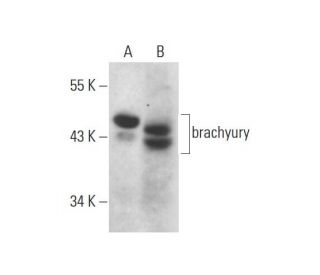


brachyury Antibody (D-10): sc-166962
- brachyury Antibody (D-10) is a mouse monoclonal IgM κ brachyury antibody, cited in 21 publications, provided at 200 µg/ml
- specific for an epitope mapping between amino acids 375-393 near the C-terminus of brachyury of human origin
- recommended for detection of brachyury of mouse, rat and human origin by WB, IP, IF and ELISA
- available conjugated to HRP for WB, IHC(P) and ELISA
- TransCruz reagent for ChIP application (sc-166962 X, 200 µg/0.1 ml)
- At present, we have not yet completed the identification of the preferred secondary detection reagent(s) for brachyury Antibody (D-10). This work is in progress.
QUICK LINKS
SEE ALSO...
brachyury Antibody (D-10) is a mouse monoclonal IgM kappa antibody that detects brachyury protein of mouse, rat, and human origin by western blotting (WB), immunoprecipitation (IP), immunofluorescence (IF), and enzyme-linked immunosorbent assay (ELISA). brachyury Antibody (D-10) is available in both non-conjugated and various conjugated forms, including agarose, horseradish peroxidase (HRP), phycoerythrin (PE), fluorescein isothiocyanate (FITC), and multiple Alexa Fluor® conjugates. brachyury protein, also known as T-box transcription factor T, is crucial for early vertebrate development, particularly in the formation of the notochord and posterior mesoderm. brachyury functions as a transcription factor, activating genes necessary for mesodermal differentiation and axial patterning during embryogenesis. The T-domain, a highly conserved DNA-binding motif found in brachyury and other T-box family members, is essential for regulating gene expression. Mutations in the Tbx gene family, which includes brachyury, have been implicated in various human diseases, highlighting the importance of understanding functional mechanisms. brachyury′s ability to interact with specific proteins involved in developmental pathways further underscores its significance in embryonic development and potential implications in cancer biology, making anti-brachyury antibody (D-10) a valuable tool for researchers studying these critical processes.
Alexa Fluor® is a trademark of Molecular Probes Inc., OR., USA
LI-COR® and Odyssey® are registered trademarks of LI-COR Biosciences
brachyury Antibody (D-10) References:
- Transcription repression by Xenopus ET and its human ortholog TBX3, a gene involved in ulnar-mammary syndrome. | He, Ml., et al. 1999. Proc Natl Acad Sci U S A. 96: 10212-7. PMID: 10468588
- Mga, a dual-specificity transcription factor that interacts with Max and contains a T-domain DNA-binding motif. | Hurlin, PJ., et al. 1999. EMBO J. 18: 7019-28. PMID: 10601024
- Effects of the TWis mutation on notochord formation and mesodermal patterning. | Conlon, FL., et al. 1995. Mech Dev. 49: 201-9. PMID: 7734393
- Immunohistochemical analysis of the Brachyury protein in wild-type and mutant mouse embryos. | Kispert, A. and Herrmann, BG. 1994. Dev Biol. 161: 179-93. PMID: 8293872
- Three novel T-box genes in Caenorhabditis elegans. | Agulnik, SI., et al. 1997. Genome. 40: 458-64. PMID: 9276934
Ordering Information
| Product Name | Catalog # | UNIT | Price | Qty | FAVORITES | |
brachyury Antibody (D-10) | sc-166962 | 200 µg/ml | $316.00 | |||
brachyury Antibody (D-10) HRP | sc-166962 HRP | 200 µg/ml | $316.00 | |||
brachyury (D-10) Neutralizing Peptide | sc-166962 P | 100 µg/0.5 ml | $68.00 | |||
brachyury Antibody (D-10) X | sc-166962 X | 200 µg/0.1 ml | $316.00 |
